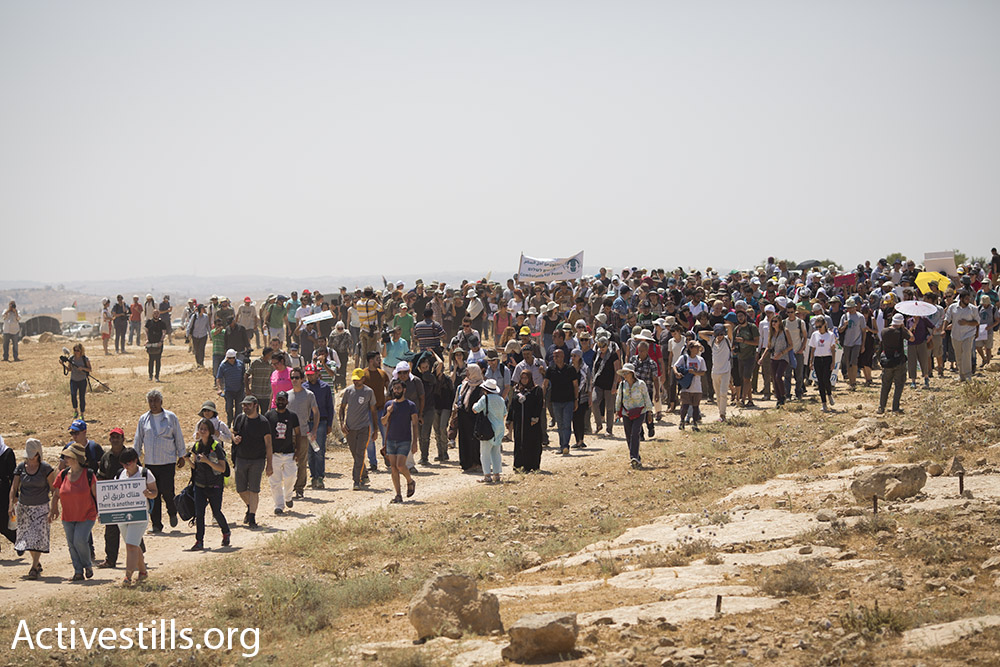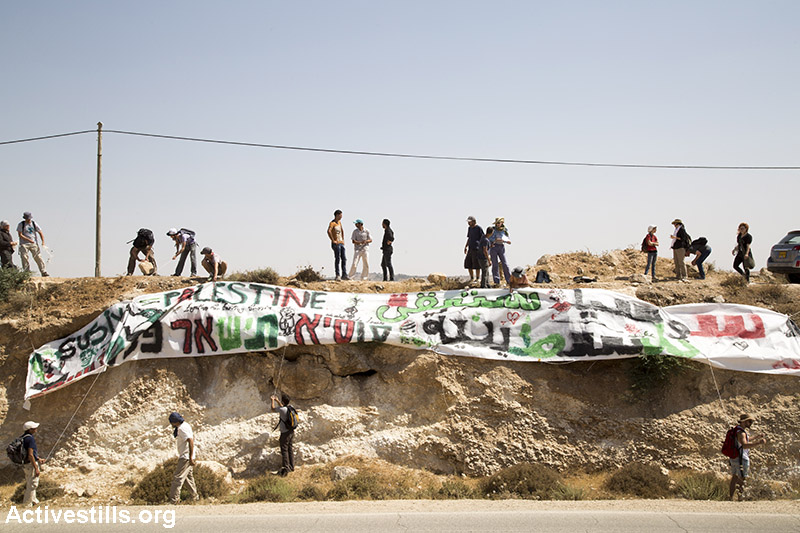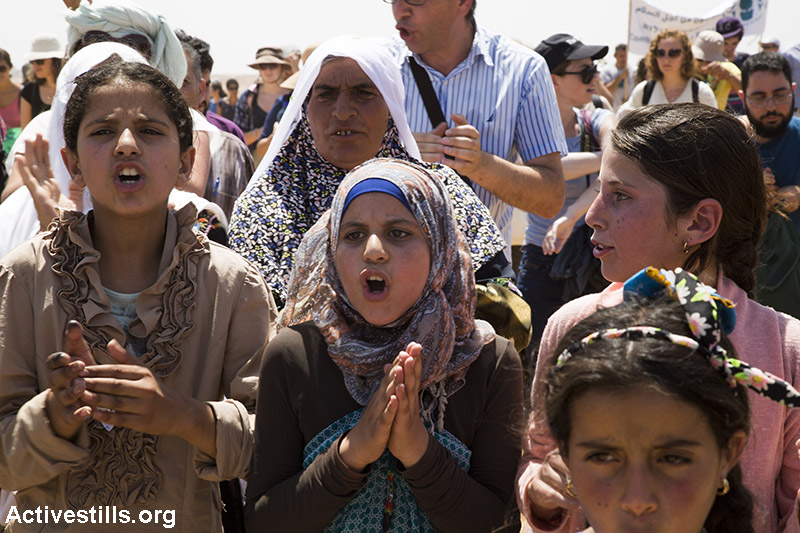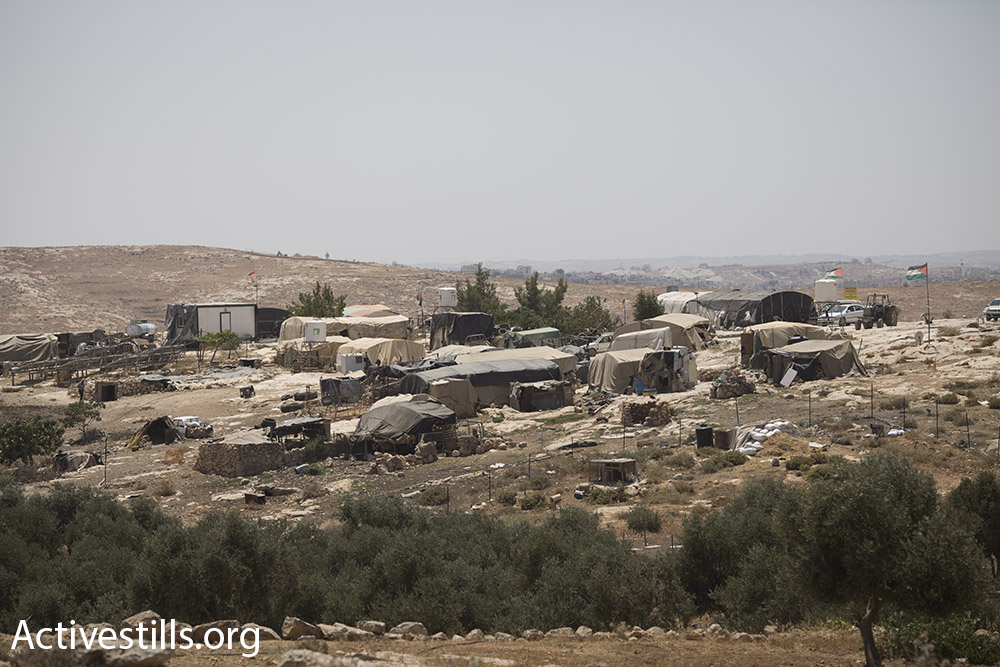Despite a pending High Court case, the village is facing imminent destruction and forced population transfer. State Department, EU foreign ministers have all called on Israel to let the villagers stay on their land.

Over 500 Palestinian, Israeli and international activists descended on the tiny Palestinian tent-village of Susya on Friday to protest its imminent demolition and the forced transfer of its residents.
The activists marched through the village, stopping at various homes along their way to hear the stories of families facing eviction and transfer.
At the end of the demonstration activists hung a massive banner in view of passing settlers, declaring that Susya is here to stay.

Palestinian parliamentarian Mustafa Barghoutti, one of few politicians who attended the protest, praised the non-violent popular resistance model adopted by the residents of Susya and many other Palestinian villages. “Combining popular resistance on the ground, international solidarity and boycott, divestment and sanctions against Israeli policies,” Barghoutti said, “is very productive and very effective at this stage.”
Susya has been the recipient of seemingly unprecedented international diplomatic and media attention in recent weeks and months. European foreign ministers, the U.S. State Department, and activists around the world are all demanding that Israel refrain from destroying the village and to legalize its status.
The Israeli army first demolished the village of Khirbet Susya, deep in the desolate south Hebron Hills, three decades ago, on the grounds that it was located on an archeological site. Susya’s residents, many of whom lived in caves on the site for generations, packed up and moved a few hundred meters away, onto their adjacent agricultural lands.
The IDF, which as the occupying power controls nearly every aspect of Palestinians’ lives in the West Bank, never recognized the validity of the move. To this day, the village has no connections to electricity or running water, and its access roads are not paved.
On the other hand, when it comes to unauthorized Jewish settlements, all of which squat on Palestinian land, Israeli authorities supply electricity, water, security and more. The terms “double standard” or “discrimination” don’t even begin to describe the dual realities in that part the West Bank.

The Israeli army has issued repeated demolition orders against the village on the grounds that none of its tents and tin shacks were erected with the proper permits. The army’s Civil Administration, however, rejects 90 percent of Palestinian planning requests.
The army has made no attempt to find a legal solution that would allow Susya’s residents to stay on their land. It intends to transfer them to the nearby city of Yatta, which is in Area A – under Palestinian Authority rule. Susya is in Area C.
Twenty years ago, on an explicitly temporary and transitional basis, the Oslo Accords divided the West Bank into three “Areas”: A, B and C. Area C, which comprises over 60 percent of the West Bank, is under full Israeli control. A significant portion of the current Israeli government has explicitly stated its desire to annex this area to Israel, in contravention of international law.
In such a scenario, Israel would want to annex as much land as possible with as few Palestinians as possible – hence, efforts and plans to transfer and dispossess Bedouin and Palestinian residents of the south Hebron Hills and Jordan Valley.

Speaking during a solidarity visit to Susya with other diplomats last month, UN Humanitarian Coordinator Daniela Owen said that Israeli plans to destroy the village could amount to forced transfer. Such a move “would be contrary to Israel’s obligations under the Fourth Geneva Convention, International Humanitarian Law and human rights law obligations.”
Susya’s residents are currently fighting in the Israeli High Court of Justice in one last bid to stay on their land. That case is pending, but two months ago a High Court justice, who just happens to be a West Bank settler himself, refused to issue an injunction against the demolition while the case is pending.
Military bulldozers have been parked adjacent to the village of Susya for some weeks now and residents were reportedly told that the demolitions would take place after the Muslim holy month of Ramadan, which ended last week.
Villagers are hoping that the international spotlight put on their struggle might be enough to save their homes from what otherwise appears to be imminent destruction and forced population transfer of its roughly 300 residents.


